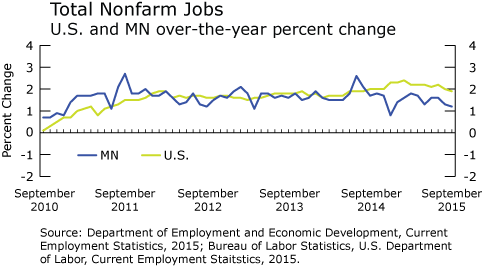by Nick Dobbins
October 2015
Monthly analysis is based on unadjusted employment data.
Employment in the Minneapolis-St. Paul-Bloomington MSA was down in September as the metro lost 3,503 jobs (0.2 percent) on the month. Government employment added 15,254 jobs (6.7 percent) with the largest part of the increase 11,110 (16.3 percent) in Local Government Educational Services as school employees began to return for the fall. However, this increase was more than overcome by smaller numbers of job losses in a variety of industry groups. Chief among the losses was a drop of 3,979 (4.9 percent) in Mining, Logging, and Construction as the summer season began winding down. Other supersectors to shed jobs included Trade, Transportation, and Utilities (down 3,963, 1.1 percent), Leisure and Hospitality (down 5,823, 3 percent), and Other Services (down 3,388, 4.2 percent). Over the year, the Twin Cities metro added 35,154 jobs (1.8 percent). Employment in Other Services dropped sharply, down by 3,353 (4.2 percent) over the year, joining Government (down 1,117 or 0.5 percent) and Information (down 224 or 0.6 percent) as the only supersectors to lose jobs on the year
The Duluth-Superior MSA added 338 jobs (0.2 percent) in September. Most supersectors lost jobs on the month, but a large increase in Government employment (up 1,909 or 7.9 percent) covered those losses. Educational and Health Services (up 63 or 0.2 percent) and Mining, Logging, and Construction (up 29 or 0.3 percent) also added jobs in September. Leisure and Hospitality (down 1,082 or 6.8 percent) and Professional and Business Services (down 114 or 1.3 percent) were among the supersectors with the biggest job losses. Annually, employment in Duluth was up by 695 jobs (0.5 percent). The Other Services supersector, which was among the biggest over-the-month job losers, showed the largest proportional growth over the year, adding 263 jobs (4.4 percent). Other noteworthy annual growth occurred in Educational and Health Services (up 653 or 2.1 percent), Mining, Logging, and Construction (down 267, 2.6 percent), and Professional and Business Services (116, 1.4 percent).
The Rochester MSA dropped 1,061 jobs (0.9 percent) in September, which represents the largest proportional decline in any MSA in the state. Rochester is the only MSA not to see significant growth in Government employment in September (down 30 or 0.2 percent), and it also had uncommon job losses in Educational and Health Services (down 370 or 0.8 percent), both of which likely contributed to its weaker-than-normal performance. Annually, employment in Rochester was up by 413 jobs (0.4 percent), with notable growth in Trade, Transportation, and Utilities (up 432 or 2.5 percent) and Information (up 126 or 6.3 percent), among other industry groups.
Employment in the St. Cloud MSA was up 1,011 jobs (1 percent) over the month. The growth came largely on the strength of an additional 1,584 jobs (11.8 percent) in Government employment, with 1,444 of that coming from State Government. The only other supersector in the MSA to add jobs was Professional and Business Services, which was up just 120 (1.5 percent). Every other supersector lost jobs in September. Annually, St. Cloud lost 213 jobs (0.2 percent), making it the only metro area in Minnesota to lose employment on the year. The largest numeric and proportional employment decline came in Mining, Logging, and Construction, which lost 270 jobs (4.1 percent).
Employment in the Mankato-North Mankato MSA was up by 1,004 (1.8 percent) in September. While most of that gain came from Government employment (up 844, 10.5 percent), the private sector chipped in with the addition of 160 jobs (0.3 percent). Service providers did most of the heavy lifting, adding 989 jobs (2.2 percent) to the goods producers' 15 (0.1 percent). Over the year, Mankato's employment was essentially flat, adding 17 jobs (0 percent) with goods producers adding 145 jobs (1.4 percent) and service providers losing 128 (0.3 percent).
The Fargo-Moorhead MSA added 2,759 jobs (2.0 percent) in September, with Government employment (up 2,765 or 17.3 percent) once again driving the growth. The sharpest decline in jobs came in Mining, Logging, and Construction, which lost 268 (2.8 percent). Over the year, the Fargo-Moorhead MSA added 1,493 jobs (1.1 percent). Notable sources of growth included Leisure and Hospitality (up 1,003 or 7.1 percent), Government (up 602 or 3.3 percent), and Financial Activities (up 361 or 3.4 percent). As was the case over the month, the largest employment decline came from Mining, Logging, and Construction, which lost 324 jobs (3.3 percent) on the year.
Employment in the Grand Forks-East Grand Forks MSA was up by 2,263 (4.0 percent) in September. This was by far the largest proportional increase of any MSA in the state for the month. As was the case elsewhere, Local Government employment drove the growth, up 1,575 (37.7 percent), contributing to the addition of 2,193 jobs among all Government employers. Over the year, employment in the MSA was up by 920 (1.6 percent). The biggest numerical growth came in Trade, Transportation, and Utilities, which added 650 jobs (5.1 percent) while the largest proportional growth was in Mining, Logging, and Construction, which added 305 jobs (8.7 percent). Educational and Health Services employment had the most notable decline, down 273 (2.9 percent).
